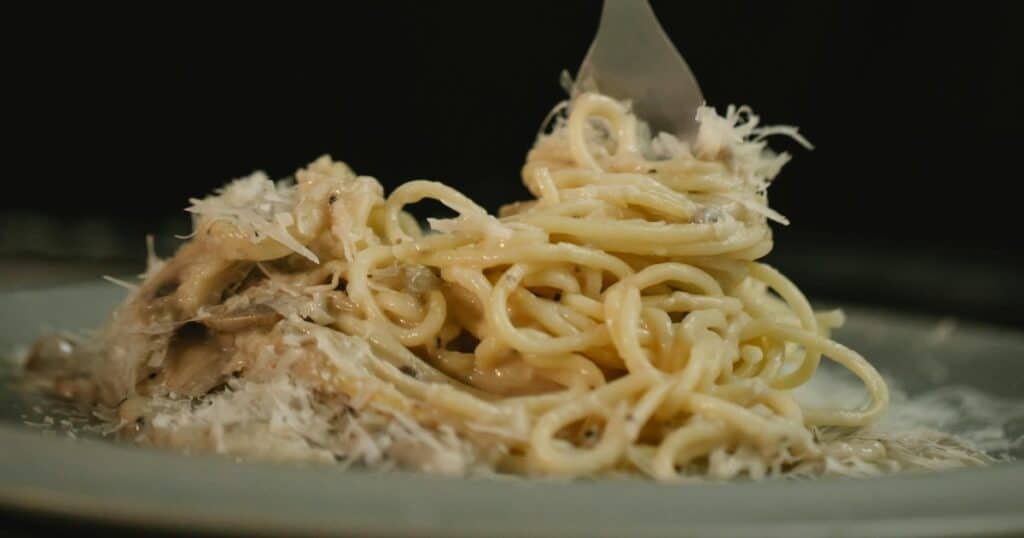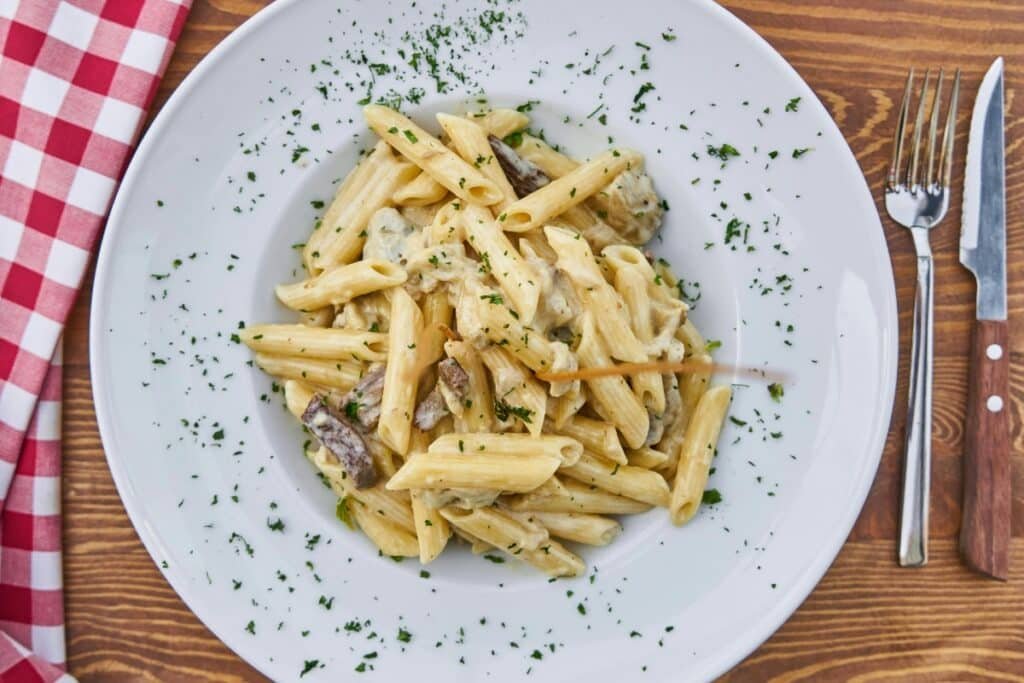Alfredo Sauce: The Best Homemade Recipes and Tips
Alfredo sauce is a rich, creamy pasta sauce that has become a beloved staple in Italian cuisine. Originating from Italy, this luscious sauce has found its way into kitchens around the world, enhancing everything from classic fettuccine to creative pizza toppings. This comprehensive guide will walk you through everything you need to know about making, using, and perfecting this sauce. From traditional recipes to healthy variations and serving suggestions, we have it all covered.

Introduction to Alfredo Sauce
This creamy white sauce, a delectable mixture of butter, cream, and Parmesan cheese, first gained popularity in the early 20th century. Named after Alfredo di Lelio, a Roman chef who created the dish to please his wife, the sauce quickly became famous for its creamy texture and rich flavor. Over the years, it has evolved, incorporating various ingredients and techniques to suit different tastes and dietary preferences.
But why is this sauce so beloved? For one, it’s incredibly versatile. While traditionally served with pasta, especially fettuccine, it can be used in numerous other dishes. Moreover, it’s relatively simple to make at home, allowing even novice cooks to create a restaurant-quality meal. With just a few ingredients and some basic cooking skills, you can whip up a sauce that rivals any you’d find in an Italian trattoria.
Whether you’re a long-time fan or a newcomer eager to try your hand at this classic sauce, this guide will provide all the information you need. We’ll delve into the essential ingredients, detailed recipes, variations for different dietary needs, and even some handy tips to avoid common mistakes. So, let’s get started on your journey to mastering the art of this creamy delight.
What is Alfredo Sauce?
Definition and Characteristics
This creamy white sauce is made primarily from butter, heavy cream, and Parmesan cheese. This trio of ingredients creates a rich, smooth texture that coats pasta beautifully. The original recipe is simple, relying on high-quality ingredients to deliver maximum flavor.
Traditionally, this sauce is prepared by melting butter in a pan, adding heavy cream, and then stirring in freshly grated Parmesan cheese until it melts and blends into a silky sauce. The result is a luscious, cheesy, and incredibly indulgent sauce that’s perfect for pasta.
Traditional vs. Modern Variations
While the classic recipe remains popular, modern variations have emerged to cater to diverse palates and dietary needs. Some recipes add garlic for an extra layer of flavor, while others incorporate different cheeses, such as Pecorino Romano or Gouda, to create unique taste profiles.
In recent years, lighter versions have also gained traction. These typically replace heavy cream with milk or a combination of milk and flour to achieve a similar creamy texture without all the fat. Vegan versions, made with ingredients like cashew cream or nutritional yeast, offer a dairy-free alternative that’s equally delicious.
As you can see, the world of this sauce is vast and varied. Whether you stick to the traditional recipe or experiment with modern twists, there’s no wrong way to enjoy this beloved sauce.
Next, we’ll dive into the essential ingredients you’ll need to make the perfect sauce at home. Ready to get cooking? Let’s go!
Ingredients for Alfredo Sauce
Traditional Ingredients
To make an authentic Alfredo sauce, you need just a handful of high-quality ingredients. These components come together to create a rich, creamy sauce that’s both simple and delicious.
Butter
Butter forms the base, providing a rich, creamy foundation. Unsalted butter is typically used to control the amount of salt in the final dish. For best results, opt for high-quality butter with a high fat content.
Heavy Cream
Heavy cream adds the luxurious, smooth texture that Alfredo sauce is known for. It’s important to use heavy cream rather than milk or half-and-half to achieve the proper consistency and richness. The high fat content in heavy cream helps the sauce emulsify and thicken without the need for additional thickeners.

Parmesan Cheese
Parmesan cheese is the star, delivering a sharp, savory flavor. Freshly grated Parmesan is essential, as pre-grated cheese often contains additives that can prevent it from melting smoothly. For an even more intense flavor, you might consider using Parmigiano-Reggiano, the king of Parmesan cheeses.
Optional Additions
While the traditional ingredients are sufficient to make a delectable Alfredo sauce, many recipes include optional additions to enhance the flavor and complexity of the sauce.
Garlic
Garlic is a popular addition that brings a subtle, aromatic depth. A clove or two, minced and sautéed in butter before adding the cream, can elevate the dish with a hint of savory warmth.
Nutmeg
A pinch of nutmeg adds a touch of warmth and complexity. This spice should be used sparingly, as its flavor can quickly become overpowering. Nutmeg complements the creaminess and enhances the overall flavor profile.
Salt and Pepper
Seasoning with salt and freshly ground black pepper is essential to bring out the flavors of the other ingredients. Be cautious with the salt, especially if your Parmesan cheese is particularly salty.
Now that we’ve covered the ingredients, it’s time to move on to the fun part: making the sauce. In the next section, we’ll provide a step-by-step guide to crafting the perfect Alfredo sauce at home. Stay tuned!
How to Make Alfredo Sauce
Step-by-Step Guide
Making Alfredo sauce from scratch is easier than you might think. Follow these steps to create a rich, creamy sauce that’s perfect for pasta and more.
Preparing the Ingredients
Before you start cooking, gather and prepare all your ingredients. This includes measuring out your butter and cream, grating the Parmesan cheese, and mincing any garlic if you’re using it.
Cooking Process
- Melt the Butter: In a large skillet or saucepan, melt the butter over medium heat. If you’re adding garlic, sauté it in the butter for about 1 minute until fragrant, but be careful not to burn it.
- Add the Cream: Pour in the heavy cream and stir to combine. Bring the mixture to a gentle simmer, stirring occasionally. Do not let it boil, as this can cause the cream to separate.
- Mix in the Cheese: Gradually add the grated Parmesan cheese, stirring constantly until it melts and the sauce becomes smooth. This can take a few minutes, so be patient. The cheese should fully incorporate into the cream, creating a silky, thick sauce.
- Season the Sauce: Add a pinch of nutmeg if desired, and season with salt and freshly ground black pepper to taste. Continue to stir until everything is well combined.
Tips for Achieving the Perfect Consistency
To ensure your Alfredo sauce turns out perfectly, keep these tips in mind:
- Use Fresh Ingredients: Freshly grated Parmesan and high-quality butter and cream make a noticeable difference in the flavor and texture. Read more about the importance of using fresh ingredients in sauces.
- Stir Constantly: This helps prevent the sauce from burning or sticking to the pan and ensures a smooth, even consistency.
- Avoid Overheating: Keep the heat at medium to medium-low to prevent the cream from boiling and separating.
Common Mistakes to Avoid
Making Alfredo sauce can be straightforward, but there are a few common pitfalls to watch out for:
- Overheating the Sauce: Boiling the sauce can cause it to separate, resulting in a grainy texture. Keep the heat low and stir frequently.
- Using Pre-Grated Cheese: Pre-grated cheese often contains anti-caking agents that prevent it from melting smoothly. Always grate your own Parmesan for the best results.
Now that you know how to make the perfect Alfredo sauce, it’s time to explore some variations. Whether you’re looking for a lighter version or a vegan alternative, we’ve got you covered. Up next, we’ll dive into some delicious variations of Alfredo sauce. Ready for more? Let’s keep going!
Variations of Alfredo Sauce
Light Alfredo Sauce
For those looking to enjoy the creamy goodness of Alfredo sauce without the heavy calories, a light version can be a great alternative. This variation maintains the rich flavor but uses lower-fat ingredients.
Ingredients and Recipe
- 1 cup milk (preferably whole or 2%)
- 1 tablespoon flour
- 2 tablespoons butter
- 1/2 cup grated Parmesan cheese
- Salt and pepper to taste
- Melt the Butter: In a saucepan over medium heat, melt the butter.
- Add Flour: Stir in the flour to make a roux, cooking for about 1 minute until it forms a paste.
- Whisk in Milk: Slowly add the milk, whisking continuously to avoid lumps.
- Add Cheese: Once the mixture thickens, stir in the Parmesan cheese until melted.
- Season: Add salt and pepper to taste.
This light Alfredo sauce offers a healthier option without compromising too much on flavor and creaminess.
Vegan Alfredo Sauce
For those who avoid dairy, a vegan Alfredo sauce can be a fantastic alternative. Using ingredients like cashews and nutritional yeast, you can create a rich and flavorful sauce.
Ingredients and Recipe
- 1 cup raw cashews (soaked in water for at least 4 hours)
- 1 cup vegetable broth
- 1/4 cup nutritional yeast
- 2 tablespoons olive oil
- 2 cloves garlic, minced
- Juice of 1 lemon
- Salt and pepper to taste
- Blend Cashews: Drain the soaked cashews and blend them with vegetable broth until smooth.
- Sauté Garlic: In a saucepan, heat olive oil over medium heat and sauté the minced garlic until fragrant.
- Combine Ingredients: Add the cashew mixture, nutritional yeast, and lemon juice to the saucepan. Stir until well combined.
- Season: Add salt and pepper to taste.
This vegan version is creamy and delicious, offering a perfect dairy-free alternative to traditional Alfredo sauce.
Low-Fat Alfredo Sauce
A low-fat Alfredo sauce can be a great option for those watching their fat intake. This recipe uses milk and a small amount of butter to create a lighter sauce.
Ingredients and Recipe
- 1 cup skim milk
- 1 tablespoon cornstarch
- 1 tablespoon butter
- 1/2 cup grated Parmesan cheese
- Salt and pepper to taste
- Melt the Butter: In a saucepan over medium heat, melt the butter.
- Mix Cornstarch and Milk: Dissolve the cornstarch in a small amount of milk, then add it to the saucepan along with the remaining milk.
- Heat and Stir: Stir continuously until the mixture thickens.
- Add Cheese: Stir in the Parmesan cheese until melted.
- Season: Add salt and pepper to taste.
This low-fat version allows you to enjoy Alfredo sauce with fewer calories and less fat.
Now that we’ve explored some variations of Alfredo sauce, let’s move on to serving suggestions. Whether you’re making traditional fettuccine Alfredo or getting creative with your dishes, we have some tasty ideas for you. Keep reading to discover the best ways to enjoy your homemade Alfredo sauce.
Serving Suggestions
Traditional Pairings
The classic way to enjoy Alfredo sauce is with pasta, especially fettuccine. This combination highlights the creamy, rich flavor of the sauce and creates a satisfying meal.
Fettuccine Alfredo
Fettuccine Alfredo is a quintessential Italian dish, combining wide, flat noodles with the luxurious sauce. Simply cook the fettuccine according to package instructions, toss it with your homemade Alfredo sauce, and serve immediately.
Other Pasta Dishes
While fettuccine is the traditional choice, Alfredo sauce pairs well with many other types of pasta. Try it with penne, rigatoni, or even spaghetti for a delicious twist on a classic dish.
Creative Uses
Beyond pasta, Alfredo sauce can enhance a variety of dishes. Here are some creative ways to use this versatile sauce:
Pizza Topping
Use Alfredo sauce as a base for white pizza. Spread a thin layer on your pizza dough, add toppings like grilled chicken, spinach, and mushrooms, and bake until golden and bubbly.
Dipping Sauce for Breadsticks
Serve warm Alfredo sauce as a dipping sauce for breadsticks or garlic bread. This makes a perfect appetizer or snack that’s sure to impress your guests.
Sauce for Vegetables
Drizzle Alfredo sauce over steamed or roasted vegetables for an extra layer of flavor. It pairs particularly well with broccoli, cauliflower, and asparagus.
These serving suggestions showcase the versatility of Alfredo sauce, proving that it’s not just for pasta. Next, we’ll look at the nutritional information to help you understand the health considerations of enjoying Alfredo sauce. Keep reading to stay informed!
Nutritional Information
Calories and Macronutrients
Alfredo sauce is known for its rich, creamy texture, but it’s also high in calories and fat. Here’s a general breakdown of the nutritional content:
- Calories: A typical serving of Alfredo sauce (1/2 cup) contains around 400-500 calories.
- Fat: Most of the calories come from fat, with about 40-50 grams per serving.
- Protein: Parmesan cheese contributes some protein, usually around 10-15 grams per serving.
- Carbohydrates: Alfredo sauce is low in carbs, typically under 5 grams per serving.
Health Considerations
While Alfredo sauce is delicious, its high fat content means it should be enjoyed in moderation. Here are some tips to keep in mind:
- Portion Control: Serve smaller portions to keep calorie intake in check.
- Balance Your Meal: Pair Alfredo sauce with lean proteins (like grilled chicken) and plenty of vegetables to create a balanced meal.
- Light Versions: Consider making light or low-fat versions of Alfredo sauce to reduce calorie and fat intake.
Understanding the nutritional content helps you make informed decisions about enjoying Alfredo sauce as part of a balanced diet.
Frequently Asked Questions (FAQs)
Can I make Alfredo sauce without heavy cream? Yes, you can use milk or a combination of milk and flour to achieve a similar creamy texture.
How can I store leftover Alfredo sauce? Store leftover sauce in an airtight container in the refrigerator for up to 3 days.
What is the best way to reheat Alfredo sauce? Reheat the sauce gently over low heat, stirring frequently to prevent separation.
Can I freeze Alfredo sauce? Yes, Alfredo sauce can be frozen. However, the texture may change slightly upon reheating.
How do I prevent Alfredo sauce from separating? Keep the heat low and stir constantly while cooking. Avoid boiling the sauce, as this can cause separation.
Conclusion
Alfredo sauce is a versatile and beloved staple in many kitchens. Whether you stick to the traditional recipe or experiment with light and vegan variations, this creamy delight is sure to please. Enjoy it with pasta, as a pizza topping, or in any of the creative ways we’ve discussed. Happy cooking!

